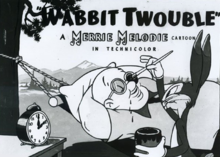


| Wabbit Twouble | |
|---|---|

Lobby card
| |
| Directed by | Bob Clampett |
| Story by | Dave Monahan |
| Produced by | Leon Schlesinger |
| Music by | Carl W. Stalling |
| Animation by | Sid Sutherland |
| Color process | Technicolor |
Production | |
| Distributed by | Warner Bros. Pictures |
Release date |
|
Running time | 8:22 |
| Language | English |
Wabbit Twouble[1] is a Merrie Melodies cartoon starring Bugs Bunny, produced by Leon Schlesinger Productions and released on December 20, 1941, by Warner Bros. Pictures.[2]
Elmer Fudd embarks on a journey to Jellostone National Park, aiming for a tranquil retreat. Upon arrival, he sets up his campsite, unknowingly positioning his tent over Bugs Bunny's rabbit hole. A mischievous Bugs Bunny plays a series of pranks on Elmer, including altering the time on his alarm clock and leading him to believe it is nighttime when it's actually daytime.
As Elmer tries to go about his routine, Bugs continues his antics, leading Elmer into perilous situations such as hanging off a cliff and encountering a grizzly bear. Despite Elmer's attempts to confront Bugs, the rabbit always manages to evade him, leading to further chaos and frustration for Elmer.
Eventually, Elmer's frustration boils over, and he vandalizes a park sign out of anger, leading to his arrest for destruction of government property. In an ironic twist, Elmer finds himself sharing a jail cell with Bugs and the bear he encountered earlier, adding to his woes.
This is the first of several Bugs Bunny films that refer to Elmer Fudd's speech impediment, with the names of Bob Clampett, Sidney Sutherland, and Carl Stalling, as well as the roles of Story, Supervision, and Musical Direction, intentionally misspelled in the credits to match the speech impediment.
Tex Avery began the project which Clampett finished; Avery is not credited on screen.[3] This was the first Bugs Bunny and Elmer Fudd cartoon directed by Clampett, with a story by Dave Monahan and musical direction by Carl W. Stalling. Although Sid Sutherland is the only credited animator, the short was also animated by Virgil Ross, Rod Scribner, and Robert McKimson. Mel Blanc provided the voices for Bugs and the bear, and Arthur Q. Bryan provided the voice for Elmer.
For the cartoon, Elmer was redesigned as a fat man (based on voice actor Arthur Q. Bryan's own physique) in an attempt to make him funnier. The "fat Elmer" would only make three more appearances in the Looney Tunes/Merrie Melodies canon – The Wabbit Who Came to Supper, The Wacky Wabbit and Fresh Hare, in addition to a cameo appearance in the war bond advertisement Any Bonds Today? – before returning to the slimmer form by which he is better known, for The Hare-Brained Hypnotist. This cartoon was the only time, though, that the "fat Elmer" also had a red nose. This is also the only cartoon with the "fat" version of Elmer still under copyright; all other "Fat Elmer" cartoons are in the public domain. Cartoon Network's anthology series ToonHeads later focused an episode on this particular design for Elmer in 1999 with "The Year Elmer Fudd Got Fat", which included Wabbit Twouble.
Animation historian David Gerstein writes, "Wabbit Twouble represents a variant on the trickster of fable and myth who doesn't wait to pester first. Clampett's Bugs invades others' lives for the fun of it—especially when those others seem, like Elmer, to be easy targets... Bugs has immediately identified Elmer as the perfect patsy and mocks his girth and mannerisms. From the point of view of the classic trickster, some people simply deserve a hard time."[4]

In December 2018, a still from the short depicting Bugs mocking Elmer by imitating his likeness became an Internet meme. The meme originated from fictitious cover art for a video game titled Big Chungus (with "chungus" being a neologism coined by video game journalist Jim Sterling in 2012)[5] which featured the still and was popularized by a Facebook post by a GameStop manager in Colorado Springs, who alleged that a customer had inquired about purchasing the fictional game as a gift for her son.[6]
In April 2021, the character was added to the mobile game Looney Tunes World of Mayhem.[7][8] Big Chungus was briefly featured in the 2021 film Space Jam: A New Legacy,[9] and eventually received a trademark from Warner Bros. themselves.[10]
| Preceded by | Bugs Bunny Cartoons 1941 |
Succeeded by |
|
Elmer Fudd in animation
| |||||||||||||||
|---|---|---|---|---|---|---|---|---|---|---|---|---|---|---|---|
| |||||||||||||||
| Short films |
| ||||||||||||||
| Feature films |
| ||||||||||||||
| TV series |
| ||||||||||||||
| TV specials |
| ||||||||||||||
|
Films directed by Tex Avery
| |||||||||
|---|---|---|---|---|---|---|---|---|---|
| Short subjects |
| ||||||||
| Characters |
| ||||||||
| Related |
| ||||||||